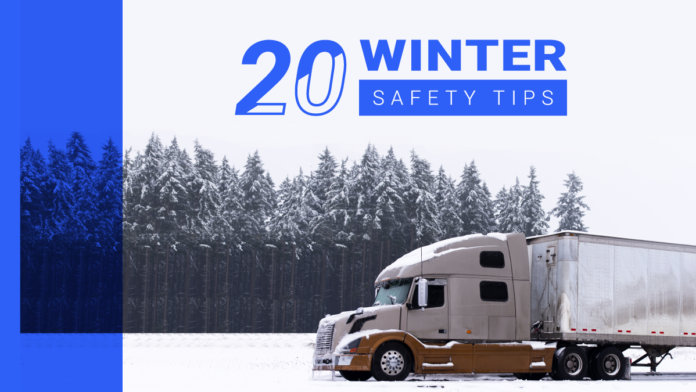Make sure you’re in a place where you can handle an emergency winter situation. It could save your life or someone else’s. We’ve put together a list of vital emergency survival items, a winter tips and tricks list, and an Hours of Service update:
20 Simple Winter Safety Tips for Truckers:
- De-fog windows using kitty litter: keep litter in a couple of socks to help absorb excess moisture from the truck and keep your windows free of fogging up on you.
- On that note: resist keeping open containers of liquid in your truck— that contributes to the fogging issue. Bonus tip: chalkboard erasers can help erase the fog without leaving smudges on the inside of your windshield.
- Bonus de-fogging tip: Coat the inside of your car windows with shaving cream (shaving cream has the same active ingredients as standard defogging chemicals) Then, wipe windows clean.
- Put that kitty litter you socked away to work: Along with your car floor mats, they can also be used to gain traction for spinning tires.
- Snow is a really terrific insulator. In an extreme situation don’t be afraid to use it for shelter if need be.
- Hydrate using water, gatorade, and other electrolyte loaded beverages: Dehydration is dangerous at any extreme temperature, even cold.
- Park facing east overnight– the rising sun will help melt snow off your truck and save you work scraping.
- Combine equal parts vinegar & water combo for melting ice on your windshield. This solution can also be used to clean road salt from boots.
- Keep your side mirrors clear: wrap them with oversize plastic bags overnight.
- Your frozen locks can be heated up using hand sanitizer. The alcohol naturally helps reduce ice build up.
- Before they freeze up you can also spray some WD-40 on your locks, which will prevent ice from building up inside to begin with.
- Stay in your truck and stay safe: in extreme conditions people die trying to walk for help.
- Keep windshield wipers clear of ice by covering them with long socks.
- Keeping those wipers raised while parked will keep them clear of snow.
- Eat food— it helps keep your core temperature up.
- In extreme temperatures, you can also wrap plastic bags on your bare feet. The plastic under your socks keeps your sweat from soaking through them and chilling you.
- Treat your diesel. Use an anti-gel additive in your tanks before you fuel
- Carry a lighter and blowtorch– depending on your need these can be used to melt parts that are freezing up.
- Cooking spray works on the rubber edges of your truck and trailer doors– it will keep them from sticking on you.
- For added visibility– brighten headlights with a toothpaste and baking soda mix.
Take some of the stress out of winter weather with our emergency kit list:
Winter Gear:
- Snow rated boots: It’s fine to be cozy in your cab, but you also need shoes that you can solve a problem with.
- Heavy Duty Winter Clothes: Especially hats—The vast majority of heat you lose will be through your head
- Breathable shell jacket to protect against the outdoor elements.
- Four-seasons-rated, down sleeping bag that cinches
- Reflective emergency blanket.
- Quality knee Pads – for maintenance such as tire changes and inspecting equipment.
- Multiple pairs of work gloves
- Heavy wool socks– wool keeps you warm even when its wet
Heating Elements:
- Keep a match and candles— drivers in dangerous situations report that heat can help keep you alive in an emergency.
- Propane heater for cab: make sure you get proper ventilation!
- Chemical hand-warmers/heat packs
- A stainless steel water bottle: you can use it to melt snow and heat water.
Mechanical issue:
- Screw drivers, wrenches, spare headlights, fuses, etc.
- Duct tape & electrical tape
- Flares/triangles
- A small tarp
- LED flashlight– Think brighter is better
- Have at least one headlamp in your truck
- Dry food supply- beef jerky, dried fruit, nuts, etc.
Fluids:
- Vinegar and water combo– To clean boots, melt windshield ice
- Windshield washer fluid
- Extra coolant
- Half-full tank – Having the fuel to burn in an emergency could be a real life-saver
- Fuel conditioner
- W-D 40 and hand sanitizer for locks
- Silicone
General:
- C.B. radio— useful to have one with the weather channel built in
- Windshield scraper with built in snowbrush
- Snow Chains
- Kitty Litter/Salt
- First aid kit— Breathing barrier with 1 way valve, gloves, cold compress, gauze, bandaids, pain killer, hydrocortisone, disinfectant wipes, etc.
- Shovels for snow should be metal, ideally made of steel
Important Note to Drivers about Hours of Service: As of September 2020 the Federal Motor Carrier Safety Administration (FMCSA) updated changes to Hours of Service (HOS) regulations during what they term as the “Adverse Driving Conditions Exception.”
During the Adverse Driving Conditions Exception that includes instances like flooding, wildfires, or hurricanes drivers are permitted an additional 2 hours of drive time. The new FMCSA rules open up the drive limit window for both on and off-duty trucking.
Steps to follow in the event of a breakdown:
- Park your truck as far off the road as you can.
- Flares: flares or triangles should be at 50, 100, and 150 feet. It can be a pain running those back in bad weather, but it’s a safety must in an emergency.
- Call your company’s breakdown or safety department.
- Tilt your hood: It indicates distress and increases visibility.
Be safe out there!
